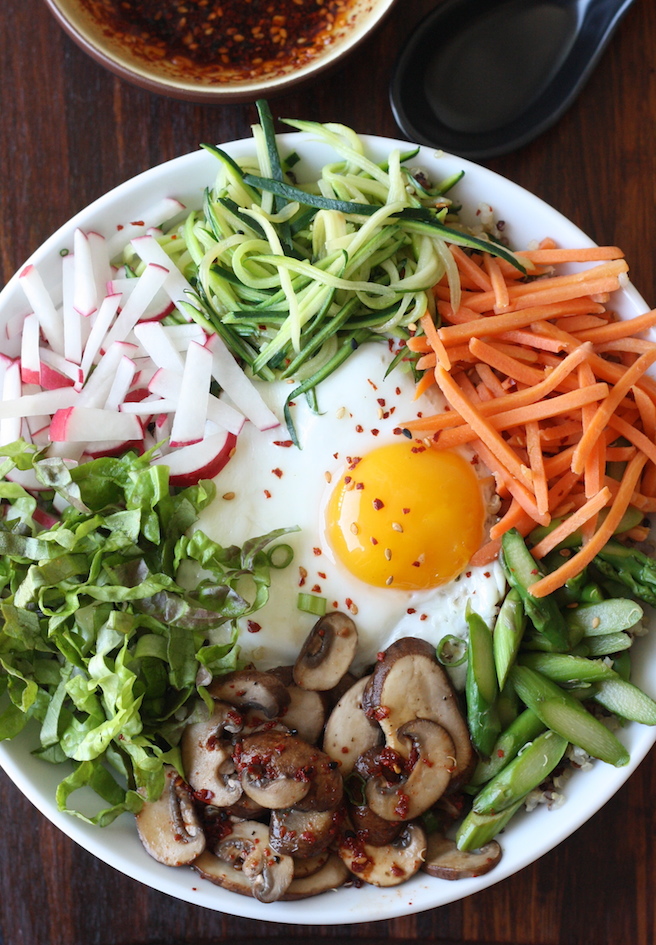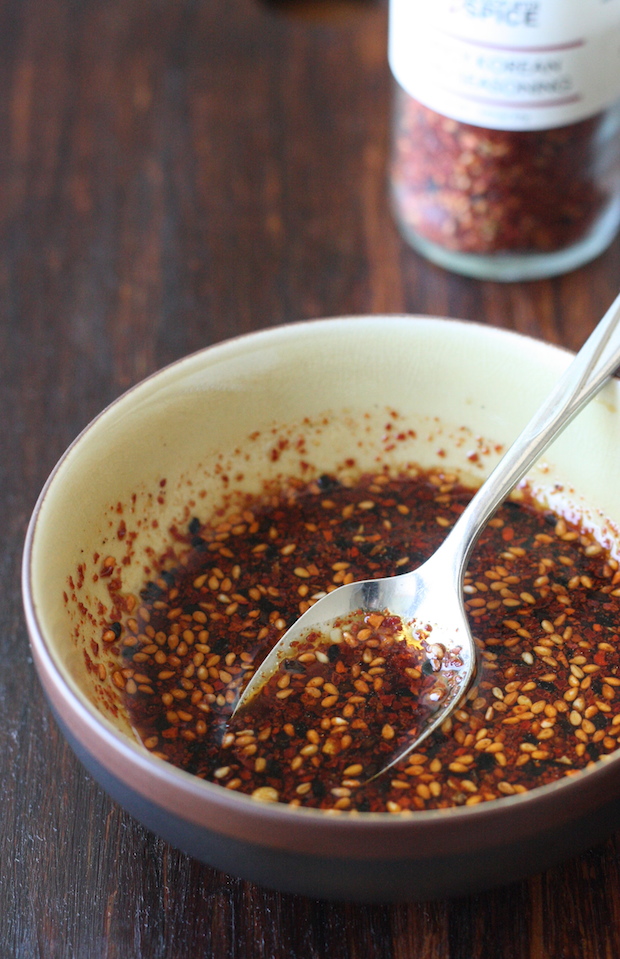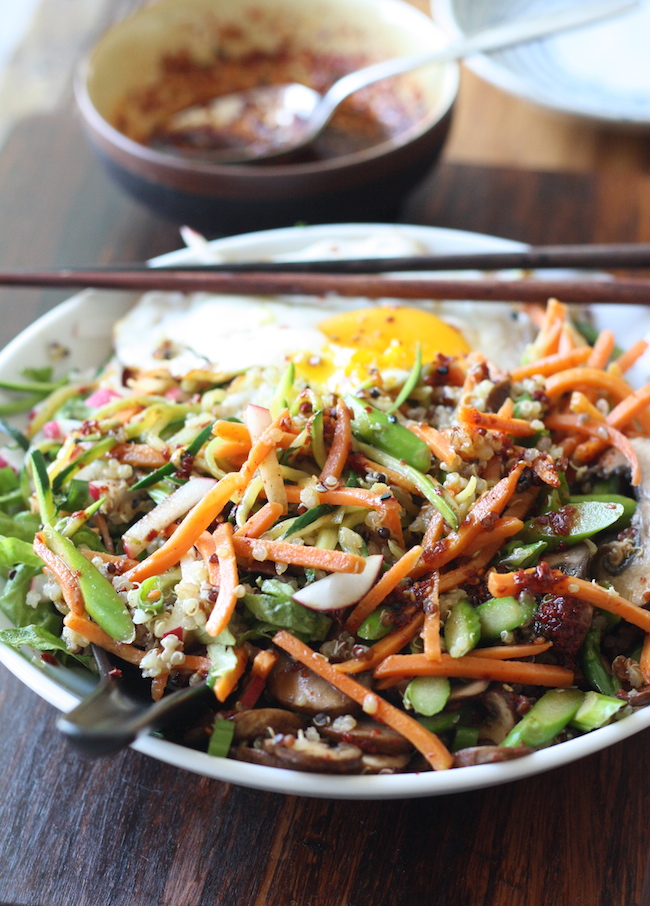A Korean dish with a little of this, a little of that, and a little more. That’s Bibimbap 비빔밥 .
The catchy name means “Mixed rice”, but every time I say it aloud – bi-bim-bap – I think “this, that, and more”. Because it’s a delicious bowl of so many textures, colors, and flavors. And it’s a fun way to use up all the extra veggies in your kitchen.
Bibimbap – a now world famous Korean dish - is generally a bowl of steamed white rice topped with an assortment of vegetables like cucumber, zucchini, daikon, and mushrooms; as well as egg, meat or seafood. It’s also served with a sweet, spicy sauce on the side that you mix in right before eating.
Today’s recipe – Quinoa Bibimbap – is a new twist to the traditional dish where I replace the rice with quinoa. The ancient grain makes a much lighter, fun alternative to rice in bibimbap, so it’s wonderful this time of year.
I also changed up the sauce, which is traditionally a richer, thicker sauce made from Korean chili paste (gochujang). Since this Quinoa Bibimbap is a much lighter meal, I created a healthier sauce by incorporating our Spicy Korean Chili Seasoning with soy sauce, rice vinegar, toasted sesame oil, and a drizzle of honey.
With leftover quinoa – from the Honey Tangerine & Quinoa Salad I made recently – and an assortment of veggies to get through, this versatile Quinoa Bibimbap becomes easy to cook up and assemble for a vibrant, healthy Korean meal.
To help you get started, here are some cooking notes:
- Prep the ingredients ahead. This will make the process surprisingly easy. The cooking takes just about 10-15 minutes if you have all the veggies cut and the quinoa cooked in advance. (And since you cooked up a big batch of quinoa, and cut so many veggies at the start of the week, you should have enough leftover to make a variety of other dishes in the following days).
- Depending on the vegetables you have on hand, you can incorporate a mix of cooked and uncooked vegetables, for a nice contrast of texture in the dish. For my recipe, I sautéed most of the veggies to soften them and to bring out the sweetness, but did include slices of raw radish and red leaf lettuce.
- Using the same skillet, cook each one of the vegetable separately. You want the vegetables to retain their tender-crisp texture, so cook each one over high heat in a short time.
- Keep the homemade Bibimbap sauce on the side until you’re ready to eat. Then pour in, toss well, and enjoy!
Quinoa Bibimbap (Korean Mixed Veggie Quinoa Bowl)
by Season with Spice
Makes 2 servings
Ingredients
Bibimbap sauce:
2 tbsp soy sauce or tamari, to taste
2 tsp Season with Spice’s Spicy Korean Chili Seasoning
2 tsp honey or raw cane sugar, to taste
1 tbsp toasted sesame oil
1 tsp rice vinegar or lemon juice
To toast the quinoa:
Toasted sesame oil
2 servings of cooked quinoa
2 tsp mirin (optional)
Toppings (here’s what I used):
2 fried eggs (optional)
5-6 mushrooms (cremini or shiitake are great) – thinly sliced
3-4 asparagus spears – thinly sliced
A large handful of shredded carrots
Half a zucchini – thinly shredded
Red leaf lettuce (thinly sliced), or a handful of spring mix
3-4 red radishes – thinly sliced
1 scallion – finely chopped
Other suggested toppings:
Spinach
Kimchi
Bean sprouts, sunflower sprouts, or any microgreen
Cucumber
Daikon
Method
1. In a small serving sauce bowl, combine the soy sauce, Spicy Korean Chili Seasoning, honey/ raw cane sugar, toasted sesame oil, and rice vinegar. Mix well and set aside.
2. In a large frying skillet, heat about 2 teaspoons of toasted sesame oil over medium-high heat. Add in the cooked quinoa and mirin (if using), mix well, and spread out in an even layer. Cook, without stirring, until quinoa is lightly toasted on the bottom, about 2 minutes. Then stir and fluff the quinoa to toast it evenly, about 2 more minutes. Dish out and divide onto your serving bowls. Cover to keep warm.
3. If you are going to serve with fried eggs, fry the eggs now. Once cooked, top each bowl of quinoa with a fried egg.
4. With the same skillet, heat two teaspoons of oil until hot. Cook the mushrooms, asparagus, carrots, zucchini one at a time over high heat. As you cook, season with a pinch of sea salt and some freshly cracked black pepper. Add small splashes of water if it gets too dry. Sauté each vegetable until tender-crisp, about 2-3 minutes per vegetable. As you finish cooking each vegetable, transfer to the bowl of quinoa, arranging it nicely in a circle.
5. Top with the rest of your selected ingredients, such as kimchi or raw vegetables like lettuce, radishes, or scallion. Serve immediately. Pour the sauce in, and toss to mix well.
Notes:
- Feel free to skip toasting the quinoa. Instead, just warm up the quinoa in the microwave.
- Cook the vegetables one at a time in sequence of longest cooking time to shortest.
by Season with Spice
Makes 2 servings
Ingredients
Bibimbap sauce:
2 tbsp soy sauce or tamari, to taste
2 tsp Season with Spice’s Spicy Korean Chili Seasoning
2 tsp honey or raw cane sugar, to taste
1 tbsp toasted sesame oil
1 tsp rice vinegar or lemon juice
To toast the quinoa:
Toasted sesame oil
2 servings of cooked quinoa
2 tsp mirin (optional)
Toppings (here’s what I used):
2 fried eggs (optional)
5-6 mushrooms (cremini or shiitake are great) – thinly sliced
3-4 asparagus spears – thinly sliced
A large handful of shredded carrots
Half a zucchini – thinly shredded
Red leaf lettuce (thinly sliced), or a handful of spring mix
3-4 red radishes – thinly sliced
1 scallion – finely chopped
Other suggested toppings:
Spinach
Kimchi
Bean sprouts, sunflower sprouts, or any microgreen
Cucumber
Daikon
Method
1. In a small serving sauce bowl, combine the soy sauce, Spicy Korean Chili Seasoning, honey/ raw cane sugar, toasted sesame oil, and rice vinegar. Mix well and set aside.
2. In a large frying skillet, heat about 2 teaspoons of toasted sesame oil over medium-high heat. Add in the cooked quinoa and mirin (if using), mix well, and spread out in an even layer. Cook, without stirring, until quinoa is lightly toasted on the bottom, about 2 minutes. Then stir and fluff the quinoa to toast it evenly, about 2 more minutes. Dish out and divide onto your serving bowls. Cover to keep warm.
3. If you are going to serve with fried eggs, fry the eggs now. Once cooked, top each bowl of quinoa with a fried egg.
4. With the same skillet, heat two teaspoons of oil until hot. Cook the mushrooms, asparagus, carrots, zucchini one at a time over high heat. As you cook, season with a pinch of sea salt and some freshly cracked black pepper. Add small splashes of water if it gets too dry. Sauté each vegetable until tender-crisp, about 2-3 minutes per vegetable. As you finish cooking each vegetable, transfer to the bowl of quinoa, arranging it nicely in a circle.
5. Top with the rest of your selected ingredients, such as kimchi or raw vegetables like lettuce, radishes, or scallion. Serve immediately. Pour the sauce in, and toss to mix well.
Notes:
- Feel free to skip toasting the quinoa. Instead, just warm up the quinoa in the microwave.
- Cook the vegetables one at a time in sequence of longest cooking time to shortest.










